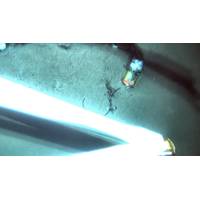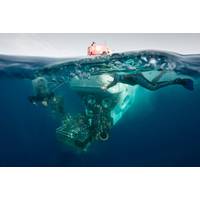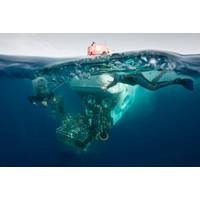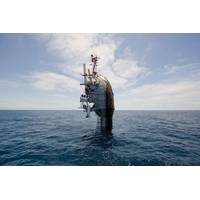
Scientists Study Largest Underwater Volcanic Eruption
the first up-close investigation of the historic volcanic eruption and reveals several surprises. “Heading to the site, we were fully prepared to investigate a typical deep-sea explosive eruption,” said Adam Soule, WHOI associate scientist and chief scientist for the National Deep Submergence Facility. “When we looked at the detailed maps from the AUV, we saw all these bumps on the seafloor and I thought the vehicle’s sonar was acting up,” Soule said. “It turned out that each bump was a giant block of pumice, some of them the size of a van. I had

Why Did the El Faro Sink?
and friends.” “Sentry and the Observation Vehicle were designed for oceanographic research with funds from the National Science Foundation, but they’re also well-suited for the task of ocean search and recovery,” said Adam Soule, chief scientist for the National Deep Submergence Facility at WHOI. “These techniques have been honed during scientific expeditions over many years supported by federal agencies. This is a tremendous example of the unanticipated use of basic research that can be applied to help benefit society.” (Source: Woods
Halls of Higher Learning
observation, computer modeling, technology development, and practical applications to real-world problems. WHOI brings together ocean experts with engineers to build innovative new technologies and tools necessary to advance ocean science. Since 1964, WHOI has operated the National Deep Submergence Facility, a federally-funded center that designs, builds and operates deep-sea exploration vehicles—Human Occupied Vehicle (HOV) Alvin, Remotely Operated Vehicle (ROV) Jason, Autonomous Underwater Vehicle (AUV) Sentry—for the benefit of the entire U.S. oceanographic community.

El Faro’s Voyage Data Recorder Located
view underwater imagery in real time and to collaborate with the team on the Atlantis. The autonomous underwater vehicle Sentry was developed with funding from the National Science Foundation and designed and built at WHOI. Managed by WHOI, the Sentry is operated through the National Deep Submergence Facility, a center funded by the National Science Foundation, the Office of Naval Research, and the National Oceanic and Atmospheric Administration and managed by WHOI. The NDSF operates, maintains, and coordinates the use of deep ocean research vehicles in coordination with the University National
UNOLS Offers Deep-Submergence Training Cruise
research and communication: seafloor-to-ship-to-shore v. data management, sharing, reporting vi. science communication UNOLS said preference will be given to researchers who have significant potential to write proposals to use the National Deep Submergence Facility (NDSF) assets Alvin, Jason, or Sentry in the next five years. The group is targeting postdoctoral researchers, assistant professors/scientists with less than seven years since their PhD. A limited number of spaces may be available to advanced PhD students. More established researchers
New Deep-Sea Vents, Volcanic Activity Found in Mariana Back-Arc
sites known globally. Only three other vents extend deeper than this newly-found vent, detected at a depth of 4230 meters (13,900 feet). The multidisciplinary group used their Woods Hole Oceanographic Institution’s Autonomous Underwater Vehicle (AUV) Sentry, operated as part of the National Deep Submergence Facility. Multibeam sonar and chemical and optical sensors were also used to hunt for the new hydrothermal oases on a track that explored a 600-km (400 mile) stretch of Pacific seafloor in the vicinity of the Marianas Trench Marine National Monument. This region, best known for including the

Upgraded Alvin Sub Passes Scientific Sea Trials
bugs in order to make Alvin‘s transfer back to science operations more seamless,” said Girguis. He is chair of the Deep Submergence Science Committee, the group of scientists from universities and organizations across the country who advise on the use of vehicles operated by the National Deep Submergence Facility at WHOI. More than three years after its last research mission, the U.S. Navy-owned Alvin returned to the scene of its last scientific dives in the Gulf of Mexico, as a substantially different vehicle. In a series of dives, pilots and scientists tested the new automatic command-and

Upgraded Alvin Sub Passes Scientific Sea Trials
bugs in order to make Alvin‘s transfer back to science operations more seamless," said Girguis. He is chair of the Deep Submergence Science Committee, the group of scientists from universities and organizations across the country who advise on the use of vehicles operated by the National Deep Submergence Facility at WHOI. More than three years after its last research mission, the U.S. Navy-owned Alvin returned to the scene of its last scientific dives in the Gulf of Mexico, as a substantially different vehicle. In a series of dives, pilots and scientists tested the new automatic command-and

Sailing for Science
(IPS) supports the operation and acquisition of major shared-use oceanographic facilities needed to carry out oceanographic-related research programs. This includes funding operations and technical services support for numerous facilities such as the Academic Research Fleet, the National Deep Submergence Facility, the National Ocean Science AMS Facility, the Monterey Accelerated Research System Cable Test-bed Facility and the Aloha Cabled Observatory. IPS also funds the development of new ocean research technology through the Ocean Technology and Interdisciplinary Coordination (OTIC) Program



 February 2024
February 2024





